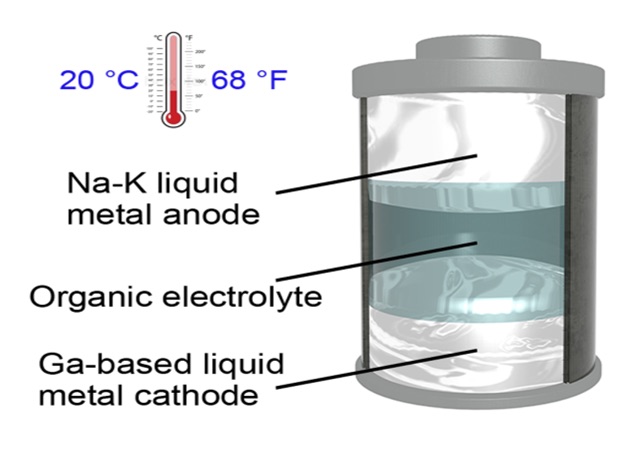Most batteries are composed of either solid-state electrodes, such as lithium-ion batteries for portable electronics, or liquid-state electrodes, including flow batteries for smart grids.

The so-called "room-temperature all-liquid-metal battery” developed by a team at The University of Texas at Austin is claimed to combine the many benefits of existing options while eliminating their key shortcomings and saving energy.
Solid-state batteries feature significant capacity for energy storage, but they typically encounter numerous problems that cause them to degrade over time and become less efficient. A Liquid-metal battery can deliver energy more efficiently, without the long-term decay of sold-state devices, but either falls short on high energy demands or require significant resources to constantly heat the electrodes and keep them molten.
The metallic electrodes in the team's battery can remain liquefied at a temperature of 20 degrees Celsius the lowest operating temperature ever recorded for a liquid-metal battery, according to the researchers. This represents a major change, because current liquid-metal batteries must be kept at temperatures above 240 degrees Celsius.
More on batteries from The Engineer
AI aids design of battery microstrucutures
Cryogenic storage could enable safe transport of car batteries
"This battery can provide all the benefits of both solid- and liquid-state - including more energy, increased stability and flexibility - without the respective drawbacks, while also saving energy," said Yu Ding, lead author of a paper on the technology published in the journal Advanced Materials.
The battery includes a sodium-potassium alloy as the anode and a gallium-based alloy as the cathode. In the paper, the researchers note that it may be possible to create a battery with even lower melting points using different materials.
The room-temperature battery promises more power than today's lithium-ion batteries, which are the backbone of most personal electronics. It can charge and deliver energy several times faster, the researchers said.
Because of the liquid components, the battery can be scaled up or down easily, depending on the power needed. The bigger the battery, the more power it can deliver. That flexibility allows these batteries to potentially power everything from smartphones and watches to the infrastructure underpinning the movement toward renewable energy.
The next step to increasing the power of the room-temperature battery comes in improving the electrolytes - the components that allow the electrical charge to flow through the battery.
"Although our battery cannot compete with high-temperature, liquid-metal batteries at the current stage, better power capability is expected if advanced electrolytes are designed with high conductivity," Ding said.




Glasgow trial explores AR cues for autonomous road safety
They've ploughed into a few vulnerable road users in the past. Making that less likely will make it spectacularly easy to stop the traffic for...